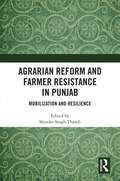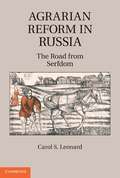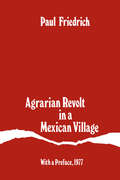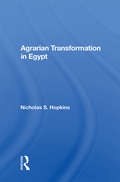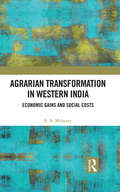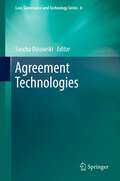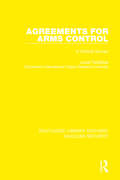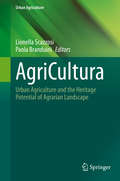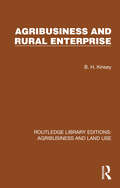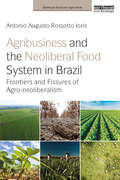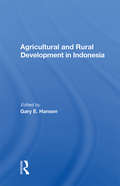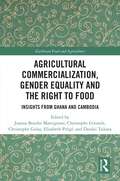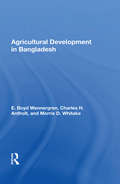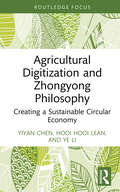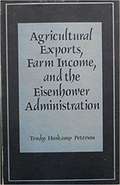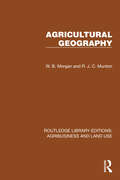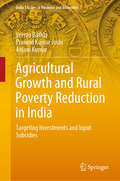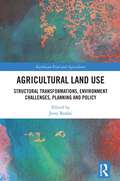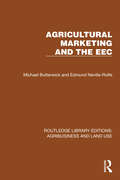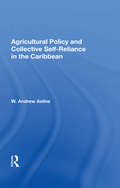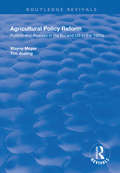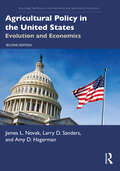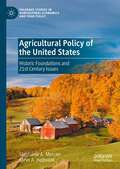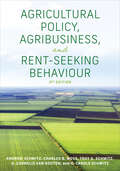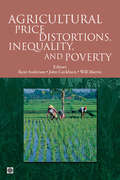- Table View
- List View
Agrarian Reform and Farmer Resistance in Punjab: Mobilization and Resilience
by Shinder Singh ThandiThis book examines the different dimensions of farmer agitations in Punjab, India. It situates the 2020–2021 farmer resistance movement within the wider context of India’s post-independent development trajectory and provides a thorough analysis of various aspects of the farmers' movement in India. The volume contextualizes Punjab’s history of farmer resistance, organization and mobilization strategies, the globalization of the movement, ways of both sustaining the movement and building resilience. While providing a critical understanding of the three farm laws introduced in India in 2020, the book looks at how they may impact farm operations and livelihoods in the post-Green Revolution period and evaluates strategies of inclusive mobilization for gathering support and sustaining the movement both within India and abroad, with special focus on the role of the Sikh diaspora. Essays in this volume also discuss the participation of women in the struggle and how their experience has the potential to transform gender relations both at home and in the public sphere. Integrated, comprehensive, and concisely written by well-known experts, this book will be of interest to those involved with Punjab’s social, political, and economic history, and students and researchers of food and agriculture in developing countries, peasant and social movements, Indian federalism and role of diasporas as non-state actors.
Agrarian Reform in Russia
by Carol S. LeonardThis book examines the history of reforms and major state interventions affecting Russian agriculture: the abolition of serfdom in 1861, the Stolypin reforms, the NEP, the Collectivization, Khrushchev reforms, and finally farm enterprise privatization in the early 1990s. It shows a pattern emerging from a political imperative in imperial, Soviet, and post-Soviet regimes, and it describes how these reforms were justified in the name of the national interest during severe crises – rapid inflation, military defeat, mass strikes, rural unrest, and/or political turmoil. It looks at the consequences of adversity in the economic environment for rural behavior after reform and at long-run trends. It has chapters on property rights, rural organization, and technological change. It provides a new database for measuring agricultural productivity from 1861 to 1913 and updates these estimates to the present. This book is a study of the policies aimed at reorganizing rural production and their effectiveness in transforming institutions.
Agrarian Revolt in a Mexican Village
by Paul FriedrichAgrarian Revolt in a Mexican Village deals with a Taráscan Indian village in southwestern Mexico which, between 1920 and 1926, played a precedent-setting role in agrarian reform. As he describes forty years in the history of this small pueblo, Paul Friedrich raises general questions about local politics and agrarian reform that are basic to our understanding of radical change in peasant societies around the world. Of particular interest is his detailed study of the colorful, violent, and psychologically complex leader, Primo Tapia, whose biography bears on the theoretical issues of the "political middleman" and the relation between individual motivation and socioeconomic change. Friedrich's evidence includes massive interviewing, personal letters, observations as an anthropological participant (e. g. , in fiesta ritual), analysis of the politics and other village culture during 1955-56, comparison with other Taráscan villages, historical and prehistoric background materials, and research in legal and government agrarian archives.
Agrarian Transformation In Egypt
by Nicholas S. HopkinsThis book reflects the argument on agrarian transformation in Egypt. It focuses on the role of agricultural mechanization in the labor process in rural Egypt. The book emphasizes the changing role of the household and the relations between households, particularly the role of women and children. .
Agrarian Transformation in Western India: Economic Gains and Social Costs
by B. B. MohantyThis book examines the economic gains and social costs of agrarian transformation in India. The author looks at three phases of agrarian transformation: colonial, post- colonial, and neoliberal. This work combines macro and micro economic data, economic and noneconomic phenomena, and quantitative and qualitative aspects while exploring the context of historical and contemporary changes with special reference to Maharashtra in western India. It discusses regional disparities in agricultural development, issues of modernisation and social inequality, land owning among scheduled castes and tribes, women in agriculture, pattern of labour migration and farmer’s suicides, and documents the experiences and conditions of the rural poor and socially weaker sections to provide a comprehensive understanding of the significant changes in agrarian rural economy of western India. It also discusses contemporary development policy and practices and their consequences. Lucid and topical, this volume will be useful to scholars and researchers of agrarian studies, rural sociology, social history, agricultural economics, development studies, political economy, political studies, and public policy, as well as planning and policy experts.
Agreement Technologies: Second International Conference, At 2013, Beijing, China, August 1-2, 2013. Proceedings (Law, Governance and Technology Series #8)
by Sascha OssowskiMore and more transactions, whether in business or related to leisure activities, are mediated automatically by computers and computer networks, and this trend is having a significant impact on the conception and design of new computer applications. The next generation of these applications will be based on software agents to which increasingly complex tasks can be delegated, and which interact with each other in sophisticated ways so as to forge agreements in the interest of their human users. The wide variety of technologies supporting this vision is the subject of this volume. It summarises the European Cooperation in Science and Technology (COST) Action project on Agreement Technologies (AT), during which approximately 200 researchers from 25 European countries, along with eight institutions from non-COST countries, cooperated as part of a number of working groups. The book is the first to provide a comprehensive overview of the emerging field of Agreement Technologies, written and coordinated by the leading researchers in the field. The results set out here are due for wide dissemination beyond the computer technology sector, involving law and social science as well.
Agreements for Arms Control: A Critical Survey (Routledge Library Editions: Nuclear Security)
by Jozef Goldblat Stockholm International Peace Research InstituteOriginally published in 1982, this is the most comprehensive handbook on arms control ever published. It contains an analysis of the bilateral and multilateral agreements reached since World War II. An assessment is made of the extent to which each agreement has affected the arms race, reduced the likelihood of war or otherwise contributed to the overall goal of disarmament. Ongoing arms control negotiations are also analyzed. The complex problem of verification of compliance with arms control obligations is critically examined, and the shortcomings of the existing arrangements are pointed out. The critique is searching, objective and free of the usual biases of official government reports. The analysis of the arms control agreements is preceded by an historical overview, beginning with the Hague Peace Conferences, held at the turn of this century, through the League of Nations' attempts to bring about a universal reduction of armaments, to the activities of the United Nations in the field of arms regulation and general disarmament. The present arms control negotiating machinery is described. The texts of the relevant documents are reproduced for handy reference and the status of the implementation of the most important multilateral arms control agreements is presented in tabular form. Tables and figures facilitate the reading.
AgriCultura: Urban Agriculture and the Heritage Potential of Agrarian Landscape (Urban Agriculture)
by Lionella Scazzosi Paola BranduiniThis book explains how cultural heritage can be a tool for enhancing urban agriculture and improving landscape and life quality. It cuts across the existing literature and fills the gaps between urban agriculture, considered as a food, social and environmental opportunity and cultural heritage, considered as resource. It focuses the role of the countryside for urban areas, in the history of the city and today. Its attention is on the quality for all areas, both outstanding, ordinary and degraded, as well as large, little or fragmented (European landscape convention 2000). It considers agricultural landscape as a system of tangible and intangible heritage components and relationships, to be retained, enhanced and transmit, in a process of inevitable but appropriate dynamic conservation and management over time (ICOMOS-IFLA Principles 2017). This book can benefit the collaboration among local players – such as farmers, citizens, associations, public institutions, stakeholders – in conserving and enhancing agrarian heritage and reinforcing the identity of places and people. It can strengthen collective action and generate positive effects on good large and local -scale management. The first part has a methodological character in order to enlighten the integrated approach between cultural heritage and urban agriculture. The second part exemplifies cases where the heritage has been recognised but not yet translated into concrete action. The third Part discloses ongoing process of co-construction, where policies have recognized the cultural, environmental and social meaning of urban agriculture as heritage. This book aims to reach scholars, local administrations, professionals, farmers and citizens. It involves many authors, many of whom are directly engaged with action-research in safeguarding and implementing the mutual interaction between urban agriculture activities and agrarian heritage.
Agribusiness and Rural Enterprise (Routledge Library Editions: Agribusiness and Land Use #25)
by B. H. KinseyOriginally published in 1987 and now reissued with a new Preface by the author, this book is written primarily for planners, public administrators and project managers in countries or international agencies considering a development strategy in which agribusiness and rural enterprise projects are viewed as a desirable policy instrument for generating employment and income. It makes available the background and methodology of project analysis so that agribusiness and rural enterprise project can be designed, implemented and reviewed effectively in a wide range of circumstances. It outlines how to establish objectively the potential and limitations of agribusiness and rural enterprise projects; provides guidelines for deciding whether a project can be effective; considers the policy issues relating to such projects and suggests techniques for judging project performance.
Agribusiness and the Neoliberal Food System in Brazil: Frontiers and Fissures of Agro-neoliberalism (Earthscan Food and Agriculture)
by Antonio Augusto IorisDue to new production areas and persistent productivity gains, Brazil has consolidated its position as a global leader and even as a ‘model’ of commercial, integrated crop production. The country is now seen as an agricultural powerhouse that has a lot to offer in terms of reducing the prospect of a looming, increasingly global, food crisis. Agribusiness and the Neoliberal Food System in Brazil focuses on the intensification of Brazilian agribusiness as a privileged entry point into the politicised geography of globalised agri-food. Drawing on rich empirical analysis based around three fieldwork campaigns in the state of Mato Grosso, the book examines the connections between farming, markets and the apparatus of the state. The importance of agribusiness expansion within the wider politico-economic context of Brazilian neoliberalism is demonstrated, thus drawing broader conclusions about the main trends of agribusiness in the world today and providing recommendations for future research. This book will be of great interest to students and scholars of agribusiness, neoliberalism and global food production, as well as those interested in Brazil and Latin America more generally.
Agricultural And Rural Development In Indonesia
by Gary E HansenThis book provides a broad, interdisciplinary overview of the major facets of Indonesia's contemporary agricultural and rural development, while exploring the macro and micro factors that account for uneven development patterns. In assessing the rate and distribution of economic growth within the rural sector of the Indonesian archipelago, the auth
Agricultural Commercialization, Gender Equality and the Right to Food: Insights from Ghana and Cambodia (Earthscan Food and Agriculture)
by Christophe Golay Elisabeth Prügl Joanna Bourke Martignoni Christophe Gironde Dzodzi TsikataThis volume explores agricultural commercialization from a gender equality and right to food perspective. Agricultural commercialization, involving not only the shift to selling crops and buying inputs but also the commodification of land and labour, has always been controversial. Strategies for commercialization have often reinforced and exacerbated inequalities, been blind to gender differences and given rise to violations of the human rights to food, land, work and social security. While there is a body of evidence to trace these developments globally, impacts vary considerably in local contexts. This book systematically considers these dynamics in two countries, Cambodia and Ghana. Profoundly different in terms of their history and location, they provide the basis for fruitful comparisons because they both transitioned to democracy in the early 1990s, made agricultural development a priority, and adopted orthodox policies of commercialization to develop the sector. Chapters illustrate how commercialization processes are gendered, highlighting distinctive gender, ethnic and class dynamics in rural Ghana and Cambodia and the different outcomes these generate. They also show the ways in which food cultures are changing and the often-problematic impact of these changes on the safety and quality of food. Specific policies and legal norms are examined, with chapters addressing the development and implementation of frameworks on the right to food and land administration. Overall, the volume brings into relief multiple dimensions shaping the outcomes of processes of commercialization, including gender orders, food cultures, policy translation, national and sub-national policies, corporate investments and programmes, and formal and informal legal norms. In doing so, it offers insight not only on our case countries, but also provides proposals to advance rights-based research on food security. This book will be of great interest to students and scholars of food security, agricultural development and economics, gender, human rights and sustainable development.
Agricultural Development In Bangladesh: Prospects For The Future
by E. Boyd WennergrenThe performance of the agricultural sector and other related areas of the economy of Bangladesh are assessed in this book, which includes descriptions and analyses of Bangladesh’s natural and human resource bases; trends in agricultural input use and production of major crops; the agricultural marketing system; public sector interventions, organization, and financing; donor programs; and the agricultural research, extension, and educational systems. The authors identify positive factors contributing to sectoral growth and development as well as specific constraints to progress and conclude by offering an overall development strategy for achieving increased agricultural productivity, complete with specific policy and programming recommendations.
Agricultural Digitization and Zhongyong Philosophy: Creating a Sustainable Circular Economy (Routledge Focus on Environment and Sustainability)
by Ye Li Yiyan Chen Hooi Hooi LeanThis interdisciplinary book combines digital technology with Eastern philosophy to examine how the concept of Zhongyong in Confucianism can be used to coordinate digital technology with sustainable agriculture. Zhongyong comes from the connotation of moderate and sustainable in ancient Chinese culture. It is with this concept in mind that this book presents a novel collaboration between philosophy and computer technology to explain how Zhongyong can play an important part in realizing agricultural digitization within a circular economy in order to help solve the current food crisis. The book examines two popular, yet contradictory, digital technologies—blockchain and the green data center. It showcases how the use of traditional Chinese Zhongyong can promote the decentralization of blockchain and the centralization of the green data center and explains the advantages of using both technologies simultaneously. The book puts forward a digital circular agricultural framework that embeds both blockchain and the green data center through an actual case study. While this book specifically focuses on agriculture, it also provides readers with a new perspective for thinking further on how to break down the disciplinary barriers between the social sciences and natural sciences. This book will be of great interest to students and scholars of agriculture, digital technologies, circular economy, sustainable development, and Eastern philosophy.
Agricultural Exports, Farm Income, And The Eisenhower Administration
by Trudy PetersonAgriculture -- Economic aspects -- United States -- History.
Agricultural Geography (Routledge Library Editions: Agribusiness and Land Use #19)
by W. B. Morgan R. J. MuntonOriginally published in 1971, this book is a systematic study of the major features and factors of the location and distribution of global agricultural enterprises. Special emphasis is given to approaches to the subject developed by economists and economic geographers, but all aspects of agricultural geography are reviewed including physical environmental problems. An introduction to the problem of classification and data collection together with instruction in some simple analytical techniques is given to equip the student with the basic methods for their own research.
Agricultural Growth and Rural Poverty Reduction in India: Targeting Investments and Input Subsidies (India Studies in Business and Economics)
by Seema Bathla Pramod Kumar Joshi Anjani KumarThis book provides a blueprint for the allocation of public expenditures “in” and “for” agriculture at the dis-aggregated state level and suggests a reorientation in favour of disadvantaged regions where the marginal returns on additional investments would be higher. It provides insights into the inter-linkages between public expenditures, private investment, rural poverty, and agriculture productivity from a regional perspective to reflect upon spatial differences in the welfare effects of various investments, subsidies, and policies. The book focuses on agricultural growth and rural poverty reduction through public and private investments, non-farm employment, and other pathways to the formulation of appropriate policies at the dis-aggregated state level. It presents new evidence based on advanced econometric tools for analysing and understanding the relationship between public and private investments in agriculture and input subsidies (fertilizer, power, irrigation, and credit) together with their impacts at the dis-aggregated state level. The book also deliberates on an income based direct support system for farmers as an alternative to the existing input price subsidy regime. Accordingly, the book offers valuable insights not only for researchers working on poverty alleviation, rural economy, and agricultural growth, but also for policymakers.
Agricultural Land Use: Structural Transformations, Environment Challenges, Planning and Policy (Earthscan Food and Agriculture)
by Jerzy BańskiThis book presents contemporary trends and challenges in agricultural land use, drawing on an array of global case studies.This volume examines agricultural land use through a three-pronged approach: structural transformations, environmental challenges, and planning and policy. Reflecting the global relevance of contemporary challenges to agricultural land use, the book presents a wide range of novel case studies from across the world, including Poland, Hungary, Denmark, Slovenia, Czechia, Tanzania, Uganda, South Africa, Algeria, Northeast Africa countries, China, India, Australia, New Zealand, USA, and Brazil. Each chapter focuses on a particular issue related to agricultural land use in that country or region, including land fragmentation, reduction of crop land, agricultural intensification, desertification of soils, climate change, biodiversity loss, traditional agricultural systems, urbanization and rural development, and planning challenges for agricultural land. Together the chapters present a global view of the challenges facing the agricultural industry and offer solutions for developing sustainable agricultural practices to ensure food security and environmental and biodiversity conservation.This book will be of great interest to students and scholars of food and agriculture, land use and land management, rural studies, and sustainable development.
Agricultural Marketing and the EEC (Routledge Library Editions: Agribusiness and Land Use #1)
by Michael Butterwick Edmund Neville-RolfeOriginally published in 1971, this book resulted from a 2-year study of the implications of the Common Market agricultural policy in relation to agricultural marketing in Britain. It provides the background to agricultural policies and explains why marketing developed differently in Britain and European countries. There are specific chapters on cereals, sugar, diary produce, horticultural products, livestock and meat, vegetable oils and oilseeds, eggs and poultry-meat and other farm products such as hops potatoes and wool). The book discusses such issues as the possible effects on British agricultural and horticultural marketing of adopting the CAP and the role played by the producer organisations.
Agricultural Policy And Collective Self-reliance In The Caribbean
by W. Andrew AxlineFocusing on the process of agricultural policy-making within the Caribbean Community and Common Market (CARICOM), this book provides a context for understanding the evolving theory of regional integration among developing countries. Dr. Axline traces the progress of Caribbean integration from its beginnings in the mid-1960s to its present state of stagnation. Drawing on original documents and extensive interviews in the twelve CARICOM member countries, he describes the move away from a market-oriented laissez-faire approach to agriculture and the shift toward sectoral programming. The role of other regional organizations, such as the Caribbean Development Bank and the Caribbean Agricultural Research and Development Institute, is examined and related to national and regional policies in the agricultural sector. The Caribbean experience, concludes Dr. Axline, suggests that the future direction of regional cooperation among developing countries will likely be toward more intensive integration on a less extensive scale.
Agricultural Policy Reform: Politics and Process in the EU and US in the 1990s (Global Environmental Governance Ser.)
by Tim Josling Wayne MoyerThis title was first published in 2002. This engaging work examines the interplay between US and EU agricultural trade policy reforms, as well as the linkage between domestic and trade policy reform, and addresses whether reform is likely to continue during the first decade of the 21st Century. Features include: - Comprehensive overview of the interplay between domestic and international agricultural policy reform - Detailed analysis of the paradigm shift in policy - Vigorous discussion of the potential impact of emerging issues such as GMOs, intellectual property rights, animal and plant health, and human safety The book offers a rich empirical account of politics and diplomacy over the last decade, providing an important background for explaining forthcoming agricultural policy debates in the US, the EU and agricultural policy negotiations in the WTO.
Agricultural Policy in the United States: Evolution and Economics (Routledge Textbooks in Environmental and Agricultural Economics)
by James L. Novak Larry D. Sanders Amy D. HagermanAgricultural Policy in the United States: Evolution and Economics traces U.S. agricultural policy from its colonial roots to the present, using economic concepts to analyze and interpret political and economic consequences. It also examines the processes by which agricultural policies are developed, and the government structure which supports the implementation of legislation passed by Congress. The book includes arguments for and against common tools of U.S. agricultural policy, without influencing the reader in a particular direction. Each chapter contains questions and exercises to support students’ learning, and technical economic material is contained in optional appendices. This second edition examines the Agriculture Improvement Act of 2018 and sets the scene for future policy developments. Additionally, it looks at trade wars and the impact of Black Swan events like the COVID-19 pandemic on agricultural resilience.
Agricultural Policy of the United States: Historic Foundations and 21st Century Issues (Palgrave Studies in Agricultural Economics and Food Policy)
by Stephanie A. Mercier Steve A. HalbrookThis book serves as a foundational reference of U.S. land settlement and early agricultural policy, a comprehensive journey through the evolution of 20th century agricultural policy, and a detailed guide to the key agricultural policy issues of the early 21st century. This book integrates the legal, economic and political concepts and ideas that guided U.S. agricultural policy from colonial settlement to the 21st century, and it applies those concepts to the policy issues agriculture will face over the next generation. The book is organized into three sections. Section one introduces the main themes of the book, explores the pre-Columbian period and early European settlement, and traces the first 150 years of U.S. agricultural policy starting with the post revolution period and ending with the “golden age” of agriculture in the early 20th century. Section two outlines that grand bargain of the 1930s that initiated the modern era of government intervention into agricultural markets and traces this policy evolution to the early days of the 21st century. The third section provides an in-depth examination of six policy issues that dominate current policy discussions and will impact policy decisions for the next generation: trade, environment/conservation, commodity checkoff programs, crop insurance, biofuels, and domestic nutrition programs.
Agricultural Policy, Agribusiness, and Rent-Seeking Behaviour, Third Edition
by Troy G. Schmitz Andrew Schmitz Charles Moss G. Cornelis van Kooten H. Carole SchmitzCosting billions of dollars annually, international trade in agricultural products is impactful and influenced by several factors, including climate change, food policy, and government legislation. The third edition of Agricultural Policy, Agribusiness, and Rent-Seeking Behaviour provides comprehensive economic analyses of the policies that affect agriculture and agribusiness in Canada and the United States. Looking at current agricultural policies, the third edition includes new chapters on food pyramids, climate change, and GMOs, while also highlighting the effect of international policies on Canadian trade, including the problematic US ethanol policy. The new edition addresses current issues, including how the COVID-19 pandemic has negatively affected agricultural value chains and played a hand in the ongoing growth in opioid use. Including a number of key findings, and discussing current debates on topics including foreign ownership of Canadian farmland, Agricultural Policy, Agribusiness, and Rent-Seeking Behaviour will appeal to students in agricultural economics and policy, as well as policymakers, agricultural firms, energy companies, and readers wishing to reduce their nation’s carbon footprint.
Agricultural Price Distortions, Inequality, and Poverty
by Kym Anderson Will Martin John CockburnThe prices of farm products are crucial determinants of the extent of poverty and inequality in the world. The vast majority of the world's poorest households depend to a considerable extent on farming for their incomes, while food represents a large component of the consumption of all poor households. For generations, food prices have been heavily distorted by government policies in high-income and developing countries. Many countries began to reform their agricultural price and trade policies in the 1980s, but government policy intervention is still considerable and still favors farmers in high-income countries at the expense of many farmers in developing countries. What would be the poverty and inequality consequences of the removal of the remaining distortions to agricultural incentives? This question is of great relevance to governments in evaluating ways to engage in multilateral and regional trade negotiations or to improve their own policies unilaterally. 'Agricultural Price Distortions, Inequality, and Poverty' analyzes the effects of agricultural and trade policies around the world on national and regional economic welfare, on income inequality among and within countries, and on the level and incidence of poverty in developing countries. The studies include economy-wide analyses of the inequality and poverty effects of own-country policies compared with rest-of-the-world policies for 10 individual developing countries in three continents. This book also includes three chapters that each use a separate global economic model to examine the effects of policies on aggregate poverty and the distribution of poverty across many identified developing countries. This study is motivated by two policy issues: first, the World Trade Organization's struggle to conclude the Doha Round of multilateral trade negotiations, in which agricultural policy reform is, again, one of the most contentious topics in the talks and, second, the struggle of the developing countries to achieve their Millennium Development Goals by 2015-notably the alleviation of hunger and poverty-which depends crucially on policies that affect agricultural incentives.
